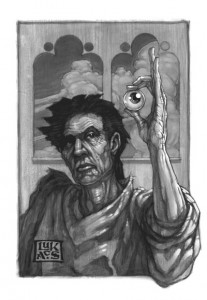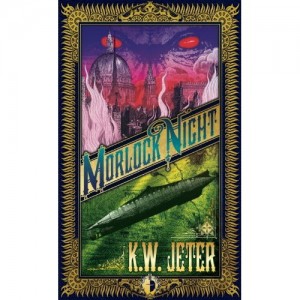When people ask me questions–well, they’re usually saying “WTF is wrong with you!?!”, or other stuff that’s hard to answer without graphs and complex math. But they sometimes ask me where I got the idea for my character Morlock Ambrosius.
When they do, I virtually always say some version of what I said to Howard A. Jones a few years ago on the Blog Gate:
The trigger for [Morlock’s] genesis was reading H. G. Wells’ The Time Machine. I enjoyed it, but felt that Wells was not really giving the Morlocks a fair shake, much as Tolkien, in his depiction of Middle Earth, arbitrarily made Dwarves inferior to his favorites, the Elves. (Don’t get me started about Elves.) At the same time, some of the Arthurian stuff I was reading was full of names that sounded like Morlock (Morgan, Morgause, Mordred, Morholt). All these elements became connected in my mind, producing this Morlock Ambrosius guy, who was connected somehow both to Dwarves and to Arthurian legend.

This is true, as far as it goes, but it may be incomplete. Someone (I wish I could remember who) pointed out to me that there was a book called Morlock Night by K.W. Jeter that holds a non-trivial place in genre history. Jeter himself is the guy who coined the term steampunk, and Morlock Night (1979) has been widely acclaimed as the leading edge of the first wave of steampunk, a subgenre that’s now swelled into a tsunami so vast it may, before it’s through, dampen all our velvet smoking jackets. More importantly, from the Morlockocentric point of view, Morlock Night mixed Wells’ Morlocks with Arthurian mythology. It seems like Jeter’s book might be the missing link in the evolutionary chain of Morlock Ambrosius. I don’t remember reading it, and I’m pretty sure I would remember reading it, but I may have seen it on bookracks or read reviews of it.
 I’ve felt for a while that I should read Morlock Night. But it’s been out of print for a long time, and I didn’t want to pay the prices I saw for used editions. (The fact that it might be on the shelves of a nearby library is something that never occurred to me until five minutes ago. But we’ll pretend that it isn’t, so that I seem like less of a doorknob.) Recently Angry Robot books reprinted it in a new edition which (a.) is incredibly beautiful, with a wonderful cover-painting and design, (b.) sports an introduction by Tim Powers, Jeter’s friend and co-founder of steampunk, and (c.) boasts an afterword by academic and sf writer Adam Roberts. How can it go wrong?
I’ve felt for a while that I should read Morlock Night. But it’s been out of print for a long time, and I didn’t want to pay the prices I saw for used editions. (The fact that it might be on the shelves of a nearby library is something that never occurred to me until five minutes ago. But we’ll pretend that it isn’t, so that I seem like less of a doorknob.) Recently Angry Robot books reprinted it in a new edition which (a.) is incredibly beautiful, with a wonderful cover-painting and design, (b.) sports an introduction by Tim Powers, Jeter’s friend and co-founder of steampunk, and (c.) boasts an afterword by academic and sf writer Adam Roberts. How can it go wrong?
Well. Ahem. I’d feel like a better, more generous person if I could stand up straight and tell you that Morlock Night is one of the world’s fifteen best things. Instead I guess I’ll just slouch here and mutter that the book is not too good. Interesting, no doubt, but not something I can recommend.
My cruel and spoiler-laden review after the jump.
Continue reading →


